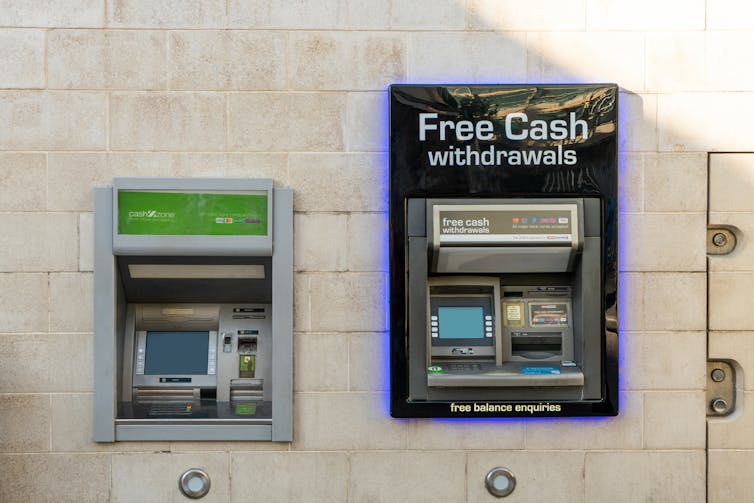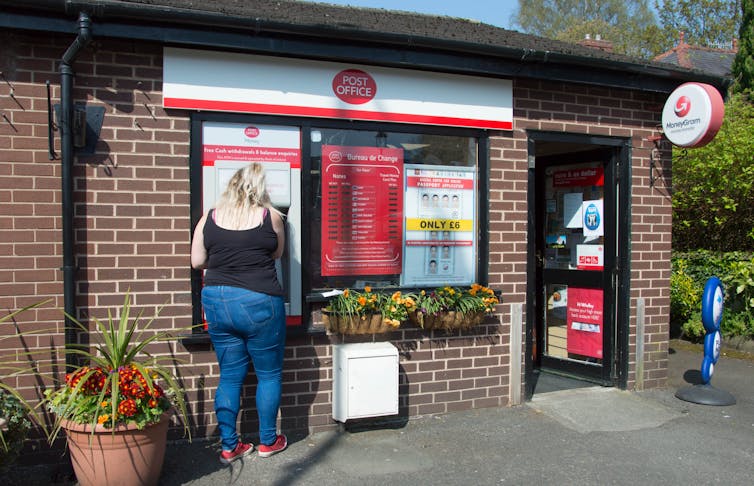
ShutterStockStudio / Shutterstock.com
Daniel Tischer, University of Bristol; Jamie Evans, University of Bristol, and Sara Davies, University of Bristol
A future without cash seems almost inevitable. Recent statistics paint a damning picture: while cash accounted for 62% of all payments by volume in 2006, this dropped to 40% in just a decade and is predicted to fall yet further to 21% by 2026.
Digital payments, on the other hand, are trending strongly in the opposite direction. Contactless payments in December 2018 in the UK were 28% higher than the same month in the previous year (at 691m in total), while the total number of card transactions increased by 12% over the same period.
In the long term, such a shift may well have benefits for many, given the speed and convenience that digital payments offer. But in the meantime, in the next five to ten years or so, there remain lots of people still dependent on cash – particularly those who are older or from lower income households. These people, it seems, are at risk of being forgotten if current trends continue. Ironically, those who are least likely to need cash have the best access to it.
Cash still king for many
We know there is still a sizeable proportion of the UK population that continues to depend on cash. An estimated 2.2m people report that they only use cash, while there are as many as 1.3m people who are “unbanked” (do not have a current account).
In our research, we regularly encounter people who find it difficult to access mainstream banking products, do not use digital payments because they find it easier to manage their money in cash, and/or simply lack trust in digital banking. For these people, cash very much continues to be king.
This means it’s important to understand the way in which access to cash is changing for the UK population. But much of the debate so far has focused on the overall number of ATMs or bank branches in the UK, without much understanding of the importance of geography. Where these dwindling number of ATMs are located makes a big difference.
Indeed, when this was studied in the early 2000s, we learnt that bank branch closures and fee-charging ATMs were more often found in poorer parts of the country. The issue was then seemingly remedied by measures such as the “Financial Inclusion Programme” put in place by LINK, the UK’s main ATM network. This programme incentivised ATM operators to provide cash machines in lower income neighbourhoods.

Michael J P / Shutterstock.com
In our new research, we therefore sought to reexamine the geography of cash provision, using Bristol as a case study. Through detailed mapping of the city’s cash infrastructure, we found stark differences in access to cash between different types of neighbourhood. Sites of economic activity, perhaps unsurprisingly, are well served; as were some of the most deprived, relatively central, neighbourhoods.
But we also found that areas we classify as “squeezed suburbs” – relatively deprived areas on the fringes of the city – were poorly catered for. This represents a significant challenge for some of the older and less well-off residents in these areas, who are most likely to depend on cash. We found Post Offices, which offer cash withdrawals and some banking services, are often geographically best-placed to serve these communities and could be a crucial asset moving forward, at least if used correctly.
Deprived areas worse off
There are signs that the situation is now changing again. Recent research revealed that around 1,700 ATMs nationwide changed from free to fee-charging at the start of 2019, likely the result of lower overall demand for cash and a recent drop in the interchange fees paid by banks when someone withdraws cash from another company’s ATM.
This was also noticeable in our research, as we gathered data both in October 2018 and March 2019. Importantly, we found that such changes were happening more often in deprived areas. Over two-thirds of the ATMs that became fee-charging in Bristol over this time period were within particularly deprived neighbourhoods.
This seems to be because ATM infrastructure in more deprived areas tends to be non-bank owned. Comparing a relatively affluent part of the city (Whiteladies Road in the Clifton neighbourhood) with a more deprived area (Stapleton Road in the Easton neighbourhood), we noticed that while just 29% of ATMs in Whiteladies Road are non-bank owned, this rises to 89% in Stapleton Road. Some such non-bank ATM owners have publicly stated that they will convert more free ATMs to fee-charging ATMs following the recent reduction in interchange fees.
This could have far-reaching implications for already under-served communities. So, while a future without cash may be almost inevitable, if the patterns found in Bristol are replicated nationally, it is likely that we’ll see a return to old geographies of financial exclusion, with deprived communities struggling most on the journey there.![]()
Daniel Tischer, Lecturer in Management, University of Bristol; Jamie Evans, Senior Research Associate, University of Bristol, and Sara Davies, Senior Research Fellow, University of Bristol
This article is republished from The Conversation under a Creative Commons license. Read the original article.
